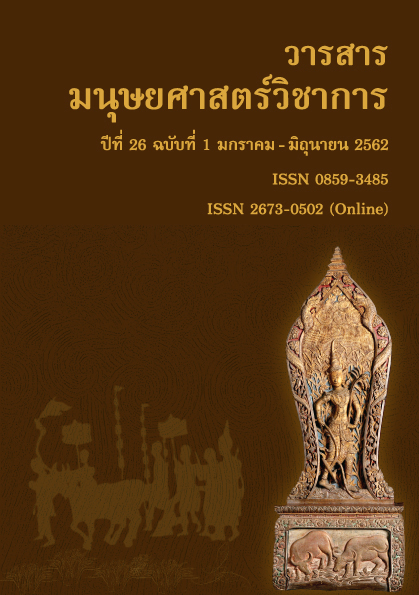การศึกษาการสอนโสตทักษะตามแนวสุดา พนมยงค์
Main Article Content
บทคัดย่อ
งานวิจัยเรื่องการศึกษาการสอนโสตทักษะตามแนวสุดา พนมยงค์ มีวัตถุประสงค์เพื่อ 1) เพื่อศึกษากระบวนการสอนวิชาโสตทักษะตามแนวสุดา พนมยงค์ 2) เพื่อศึกษาแนวทางในการนำวิชาโสตทักษะไปปรับใช้ในการบรรเลงเปียโน งานวิจัยนี้จะเป็นประโยชน์ต่อการนำไปใช้เป็นแนวทางในการสอนวิชาโสตทักษะ รวมทั้งสามารถนำไปพัฒนาหรือปรับใช้กับการเรียนเครื่องดนตรีประเภทต่างๆ รวมทั้งนำไปเป็นข้อมูลในการจัดทำหลักสูตรดนตรีในอนาคต โดยผู้วิจัยใช้ระเบียบวิธีวิจัยเชิงคุณภาพ ด้วยวิธีการสัมภาษณ์และสังเกตการสอนจากสุดา พนมยงค์ และนักเรียนเปียโนที่เคยเรียนวิชาโสตทักษะกับสุดา พนมยงค์ จำนวน 3 คน ผู้วิจัยได้แบ่งประเด็นในการศึกษา ดังต่อไปนี้ 1) การศึกษากระบวนการเรียนการสอนวิชาโสตทักษะ 2) การนำโสตทักษะไปปรับใช้ในการบรรเลงเปียโน และ 3) ประโยชน์ที่ได้รับจากการเรียนวิชาโสตทักษะตามแนวสุดา พนมยงค์
ผลการวิจัยพบว่า สุดา พนมยงค์ สอนโสตทักษะครอบคลุม 5 หัวข้อ ดังต่อไปนี้ 1) จังหวะ 2) ระดับเสียงและทำนอง 3) ขั้นคู่เสียงและกลุ่มโน้ตประสาน 4) ดนตรีหลากแนว 5) การฟังดนตรีด้วยความรู้สึกและความเข้าใจ โดยมีหลักการในการสอน คือ สอนจากความรู้สึก แล้วค่อยเชื่อมโยงไปสู่ทฤษฎี (ความเป็นวิชาการ) วิธีการในการสอนโสตทักษะของสุดา พนมยงค์ จะประกอบไปด้วย ความรู้สึก การฟัง การร้อง ความจำ การอ่าน การเชื่อมโยง และการบันทึก โดยมีเป้าหมายเพื่อให้ผู้เรียนได้ซึมซับดนตรีด้วยวิธีธรรมชาติ ผ่อนคลาย เป็นขั้นตอนอย่างมีระบบ เพื่อพัฒนาไปสู่การเรียนในขั้นสูง ส่วนการนาโสตทักษะมาปรับใช้ในการเรียนเปียโน สามารถสรุปหลักการได้ดังนี้ 1) ความเป็นธรรมชาติ 2) ความมีชีวิตชีวา 3) การผ่อนคลายร่างกายและจิตใจ 4) ความยินดีในการรับรู้ และ 5) การฝึกซ้อม จากการสัมภาษณ์และสังเกตการณ์สอนนักเรียน พบว่านักเรียนได้รับประโยชน์จากการเรียนและสามารถนำไปพัฒนาการเล่นดนตรีของตนเองให้มีคุณภาพมากขึ้น นักเรียนที่เรียนมีความเข้าใจบทเพลงมากขึ้น เข้าใจโครงสร้าง สามารถวิเคราะห์บทเพลง สามารถอ่านโน้ตแรกเห็นได้ถูกต้องแม่นยำ และมีวิธีการในการหัดบทเพลงที่มีความซับซ้อนด้วยความเข้าใจ
Article Details
เอกสารอ้างอิง
จุฑารัตน์ มณีวัลย์. (2551). การสอนโสตทักษะด้านทำนองในหลักสูตรเปียโนระดับชั้นต้นของสานักพิมพ์อัลเฟลด กรณีศึกษา โรงเรียนดนตรีปิ่นนคร (วิทยานิพนธ์ มหาบัณฑิต สาขาดนตรี). มหาวิทยาลัยมหิดล, นครปฐม.
ณรุทธ์ สุทธจิตต์. (2554). หลักการของโคดายสู่การปฏิบัติ. กรุงเทพฯ: จุฬาลงกรณ์มหาวิทยาลัย.
ณัชชา โสคติยานุรักษ์. (2547). พจนานุกรมศัพท์ดุริยางคศิลป์. กรุงเทพฯ: จุฬาลงกรณ์มหาวิทยาลัย.
สุกรี เจริญสุข. (2549). พรสวรรค์สร้างได้. นครปฐม: วิทยาลัยดุริยางคศิลป์ มหาวิทยาลัยมหิดล.


